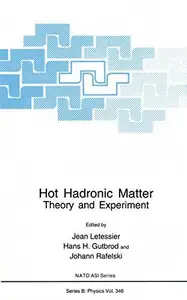
Free Download Hot Hadronic Matter: Theory and Experiment By Torleif Ericson, Maurice Jacob, Johann Rafelski, Helmut Satz (auth.), Jean Letessier, Hans H. Gutbrod, Johann Rafelski (eds.)
1995 | 574 Pages | ISBN: 1461357985 | PDF | 44 MB
The past decade has seen the development of the operational understanding of fun damental interactions within the standard model. This has detoured our attention from the great enigmas posed by the dynamics and collective behavior of strongly interacting particles. Discovered more than 30 years ago, the thermal nature of the hadronic particle spectra has stimulated considerable theoretical effort, which so far has failed to 'confirm' on the basis of microscopic interactions the origins of this phenomenon. However, a highly successful Statistical Bootstrap Model was developed by Rolf Hagedorn at CERN about 30 years ago, which has led us to consider the 'boiling hadronic matter' as a transient state in the trans formation of hadronic particles into their melted form which we call Quark-GIuon-Plasma (QGP). Today, we return to seek detailed understanding of the thermalization processes of hadronic matter, equipped on the theoretical side with the knowledge of the fundamental strong interaction theory, the quantum chromo-dynamics (QCD), and recognizing the im portant role of the complex QCD-vacuum structure. On the other side, we have developed new experimental tools in the form of nuclear relativistic beams, which allow to create rather extended regions in space-time of Hot Hadronic Matter. The confluence of these new and recent developments in theory and experiment led us to gather together from June 27 to July 1, 1994, at the Grand Hotel in Divonne-Ies-Bains, France, to discuss and expose the open questions and issues in our field.
